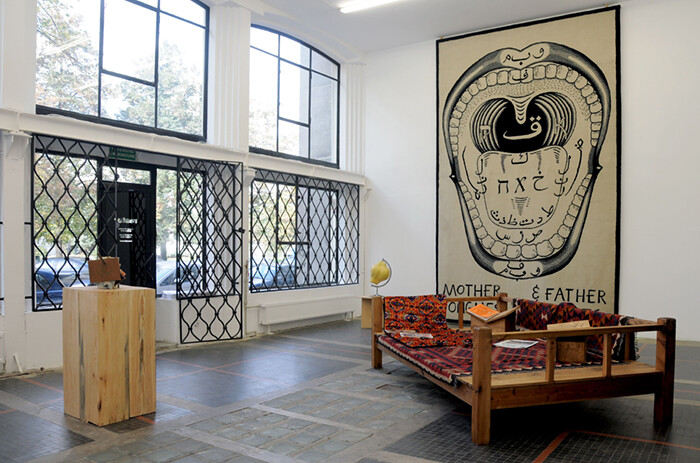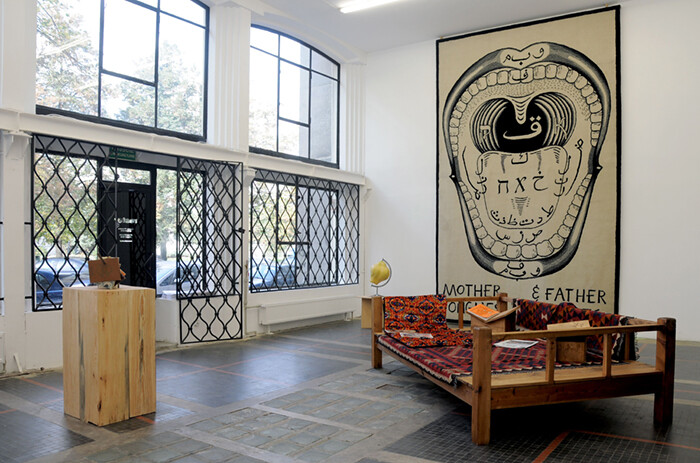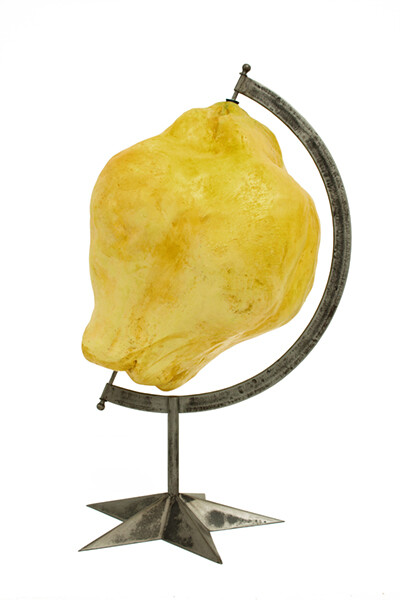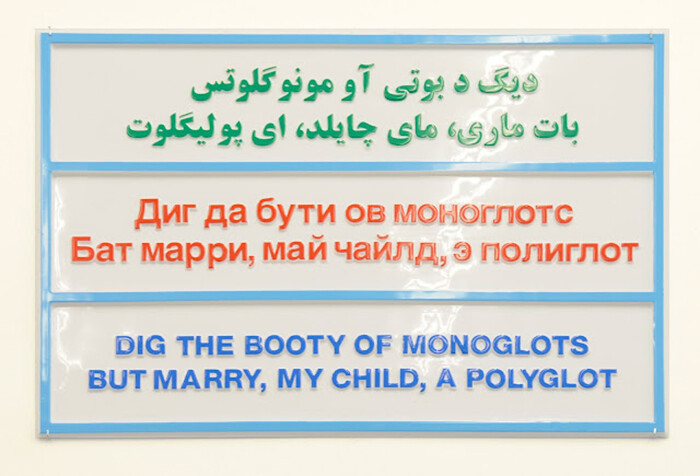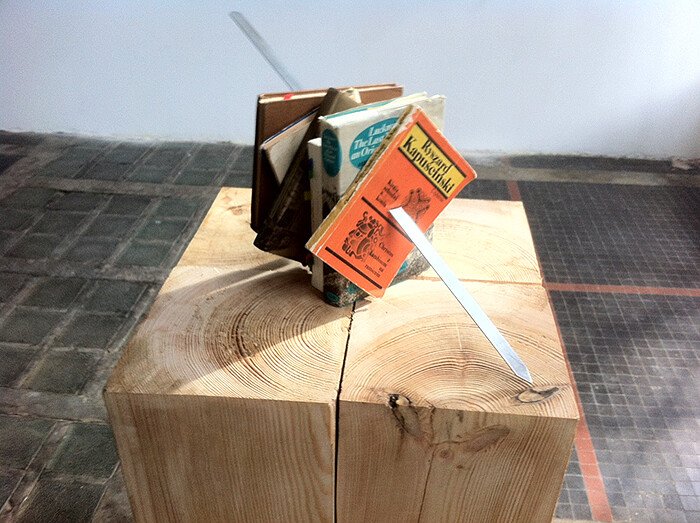In 1983, Czech writer Milan Kundera defined Central Europe as those states that historically and culturally belonged to the West, but had been politically assigned to the Eastern Bloc in the geopolitical wrangling of the Cold War. His notable essay “The Stolen West” (1983) accentuated the shared cultural heritage of the countries on both sides of the Iron Curtain and held a strategic value in defying communism. Today, over two decades after the fall of Berlin Wall and almost a decade after the European Union’s border shifted eastward, such designations sound woefully outdated. Yet the artistic collective Slavs and Tatars locate their geographical interest “east of the former Berlin Wall and west of the Great Wall of China.” Their first solo show in Warsaw is dedicated to linguistic complexities and what is lost (or gained) in translation. But what strategies lurk behind their approach?
In the center of the gallery stands a peculiar structure made of wood, a takhit, a type of furniture found in tea houses, kiosks, or restaurants across Central Asia. It resembles a bed, but lacks a mattress or upholstery and is covered instead with patterned rugs. Here it acts as a reading platform, with Slavs and Tatars’s publications placed casually on it. In their practice takhits, tent-like tea salons, small shrines, or flying carpets (like PrayWay (2012) at the New Museum’s Triennial in New York this year) are meant to bring in an impression of public space, hospitality, and generosity.
But they’re less known for their lounges, I suppose, than for research that finds form through lectures, books, and various types of artifacts. Steeped in geographically specific humor, their works go against constructing a homogenous picture of the East, emphasizing rather the idiosyncrasies and curiosities. The superficial similarities they uncover lead to crackpot theories, bilingual puns, and pure absurdities. Take the globe Slavs and Tatars fashioned, for instance, in which the Earth is substituted with an enlarged quince. The word dunya is the Arabic and Turkish word for “world” which, in turn, sounds similar to dunja (quince) in Serbo-Croatian. (The work is meant to bury a hatchet between the Turks and Serbs.) The exhibition’s title “Too Much Tłumacz” includes a homophonic translation too. “Too much” sounds like the Polish word for “translator.” So the title, if you can read both languages, would read “too much translating.” In the work Dig the Booty (2012) the aphorism “Dig the booty of the monoglots, but marry, my child, a polyglot” is transliterated into Latin, Cyrillic and Farsi, in homage to the circuitous paths of Azeri language, which in the twentieth century went through three transliterations imposed by various authorities. Consequently, generations of Azeris speak the same language, but read books written in three different alphabets.
While the artists’ statement disapproves of the power of translation, they themselves employ it incessantly. The walls around the takhit are hung with rugs, carpets, and prints, all using texts (at least bilingual, if not more) contributing to an incomprehensible linguistic brew. In the adjacent room, large-scale mirrors are painted over with short paraphrases of idioms and titles of popular books, referring to the countries or cities of the regions Slavs and Tatars are interested in. Looking at my own reflection, I learned for instance that “Men are from Murmansk / Women are from Vilnius,” or “Once a Tease, Always a Kyrgyz.” Let’s call the whole thing off!
As most of the works in the show are remnants of previous larger projects of the collective, they all needed extended captions (which were, unfortunately, missing). While a globe-quince is funny, to reach the deeper meaning one needs to plow through the collective’s books on the takhit (in this case Not Moscow Not Mecca) or attend their lectures. While the research results in books, the artworks turn out to be merely its by-products. What remains is an aura of luring exoticism: Sinbad the Sailor meets accretions of unfathomable convoluted oriental writings.
In their project comparing Iranian Revolution of 1979 and the breakdown of communism in Poland in 1989 (Friendship of Nations: Polish Shi’ite Showbiz, 2011), Slavs and Tatars delved even deeper into the past, referring to Sarmatism, a cultural formation in Baroque-era Poland, based on the conviction that Polish nobility descended from a long-lost Iranian tribe of the Black Sea, the Sarmatians. Supposedly, the Polish inherited their “national characteristics”—such as their love of freedom, hospitality, and courage—from them. But Slavs and Tatars themselves concoct similar myths. In Poland, their quixotic work serves almost as a reminder of these forgotten Eastern ties, served up as an exotic remnant proffering both wisdom and colorful decoration. In other words: intriguing—but also a little superficial.
The exhibition at Raster opened during Warsaw Gallery Weekend, which aimed to galvanize a fledgling Polish art market and bring it into the broader Western spectrum. Paradoxically, no artist or collective suits this goal better than Slavs and Tatars. But to escape the dense cobweb they spin, let’s quote the Gershwins: Potato, potahto!
